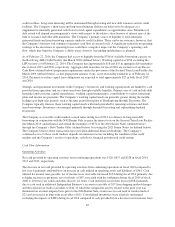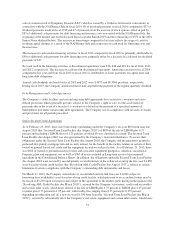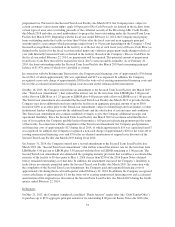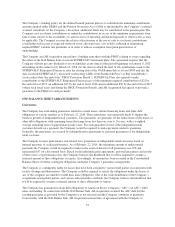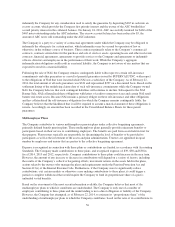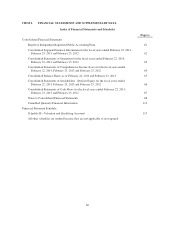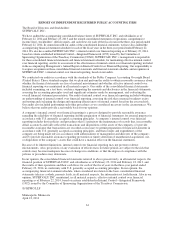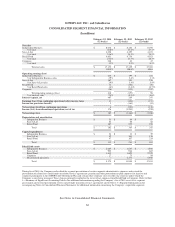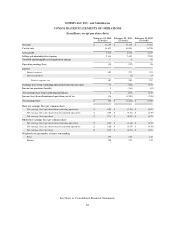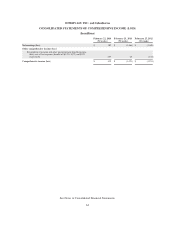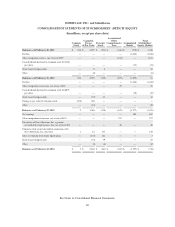Albertsons 2014 Annual Report Download - page 60
Download and view the complete annual report
Please find page 60 of the 2014 Albertsons annual report below. You can navigate through the pages in the report by either clicking on the pages listed below, or by using the keyword search tool below to find specific information within the annual report.Company agreed with the PGBC to contribute in excess of the minimum required amounts by contributing
an additional $25 by the end of fiscal 2015, an additional $25 by the end of fiscal 2016 and an additional
$50 by the end of fiscal 2017.
(2) Long-term debt amounts exclude any original issue discounts.
(3) Amounts include contractual interest payments using the interest rate as of February 22, 2014 applicable to
the Company’s variable interest debt instruments and stated fixed rates for all other debt instruments.
(4) Represents the minimum rents payable under operating leases, excluding common area maintenance,
insurance or tax payments, for which the Company is also obligated, offset by minimum subtenant rentals of
$69, $17, $32, $16 and $4, respectively.
(5) Represents the minimum payments under capital leases, excluding common area maintenance, insurance or
tax payments, for which the Company is also obligated, offset by minimum subtenant rentals of $25, $4, $7,
$6 and $8, respectively.
(6) The Company’s purchase obligations include various obligations that have annual purchase commitments of
$1 or greater. As of February 22, 2014, future purchase obligations existed that primarily related to fixed
asset and information technology commitments. In addition, in the ordinary course of business, the
Company enters into supply contracts to purchase product for resale to consumers and to Independent
Business wholesale customers which are typically of a short-term nature with limited or no purchase
commitments. The majority of our supply contracts are short-term in nature and relate to fixed assets,
information technology and contracts to purchase product for resale. These supply contracts typically
include either volume commitments or fixed expiration dates, termination provisions and other standard
contractual considerations. The supply contracts that are cancelable have not been included above.
(7) The Company’s insurance reserves include the undiscounted obligations related to workers’ compensation,
general and auto liabilities at the estimated ultimate cost of reported claims and claims incurred but not yet
reported and related expenses.
ITEM 7A. QUANTITATIVE AND QUALITATIVE DISCLOSURES ABOUT MARKET RISK
The Company is exposed to market pricing risk consisting of interest rate risk related to debt obligations and
notes receivable outstanding. Interest rate risk is managed through the strategic use of fixed and variable rate debt
and, to a limited extent, derivative financial instruments. Variable interest rate debt (bank loans, industrial
revenue bonds and other variable interest rate debt) is utilized to help maintain liquidity and finance business
operations. Long-term debt with fixed interest rates is used to assist in managing debt maturities and to diversify
sources of debt capital. Variable rate borrowings consist primarily of LIBOR and prime rate based loans with
established interest rate floors. Changes in interest rates related to debt with fixed interest rates does not have an
impact upon future results of operations and cash flow while outstanding, however, if additional debt issuance is
required to fund fixed rate debt maturities future results of operations or cash flows may be impacted.
The Company does not use financial instruments or derivatives for any trading or other speculative purposes. The
Company’s limited involvement with derivatives is primarily to manage its exposure to changes in energy prices
utilized in the shipping process, and in the Company’s stores and warehouses, and are only utilized to manage
well-defined risks. Outstanding derivatives were insignificant as of February 22, 2014.
Long-term loans are extended to certain independent retail customers in the normal course of business through
notes receivable. The notes generally bear fixed interest rates negotiated with each independent retail customer.
The market value of the fixed rate notes is subject to change due to fluctuations in market interest rates.
The table below provides information about the Company’s financial instruments that are sensitive to changes in
interest rates, including debt obligations and notes receivable. For debt obligations, the table presents principal
payments and related weighted average interest rates by year of maturity using interest rates as of February 22,
2014, applicable to variable interest debt instruments and stated fixed rates for all other debt instruments,
58



